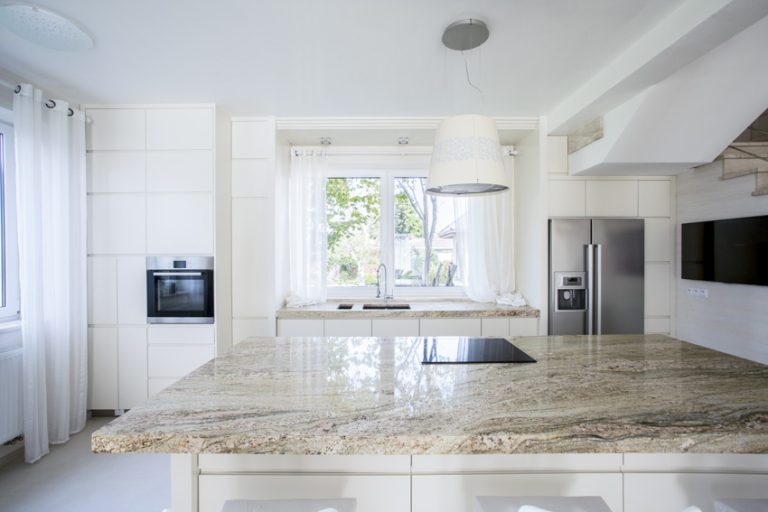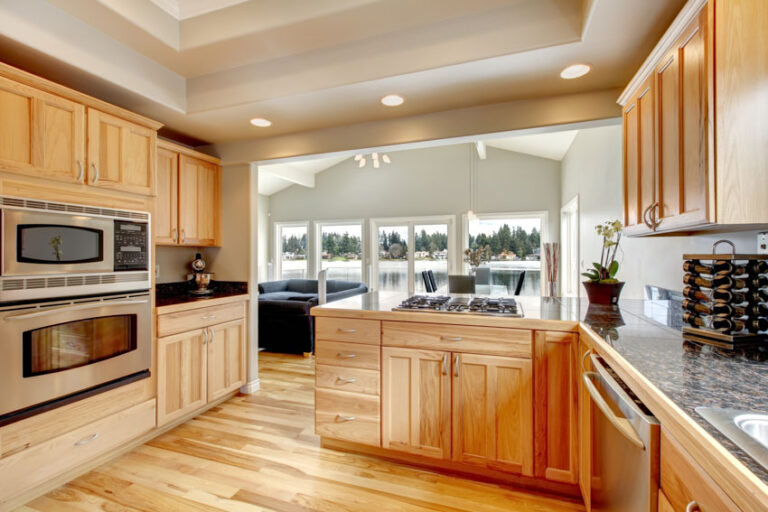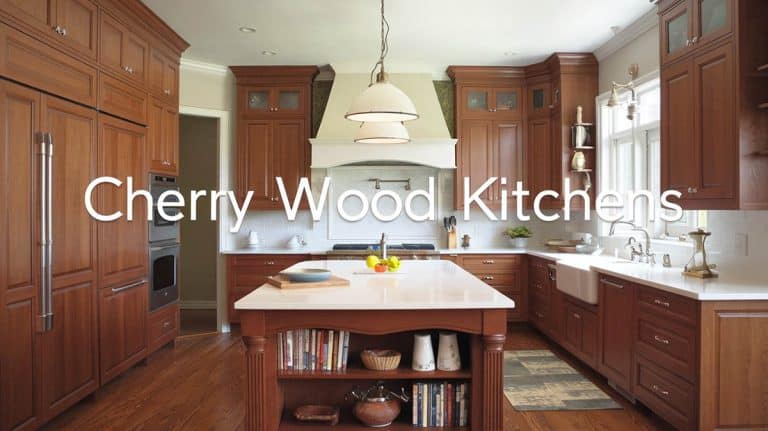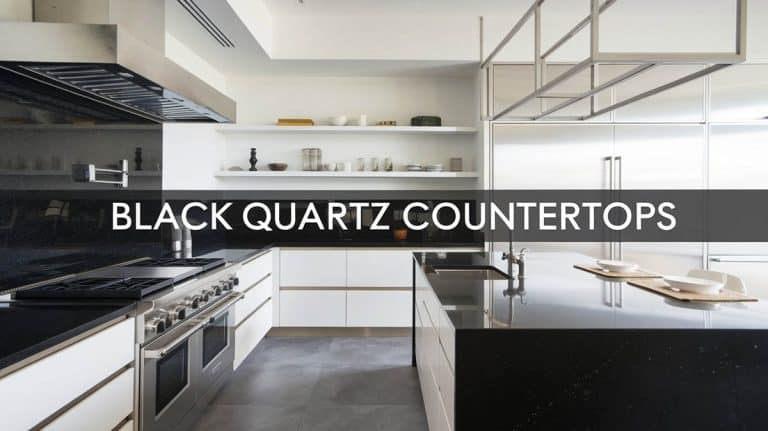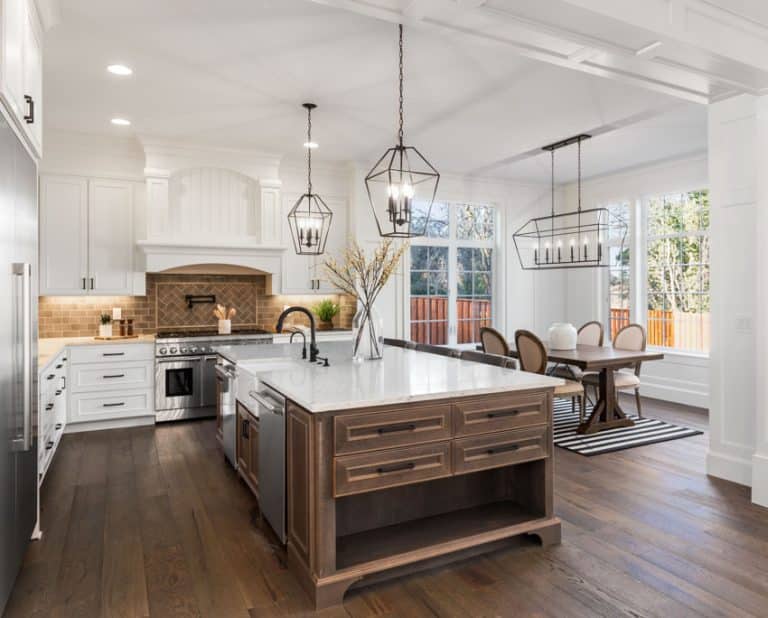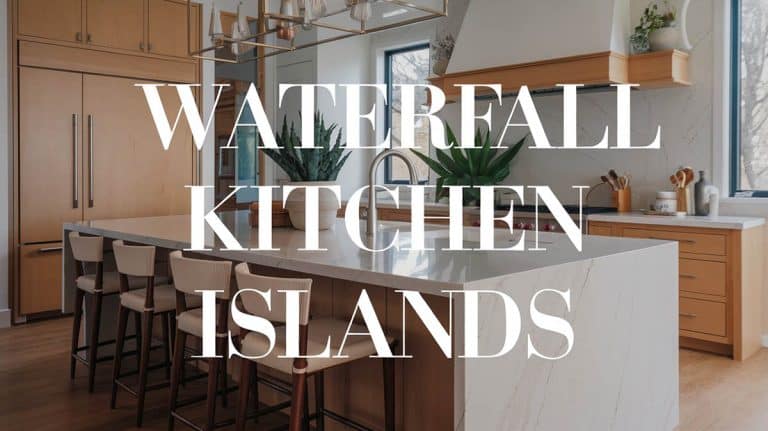How To Use Forest Green Kitchen Cabinets In Your Design
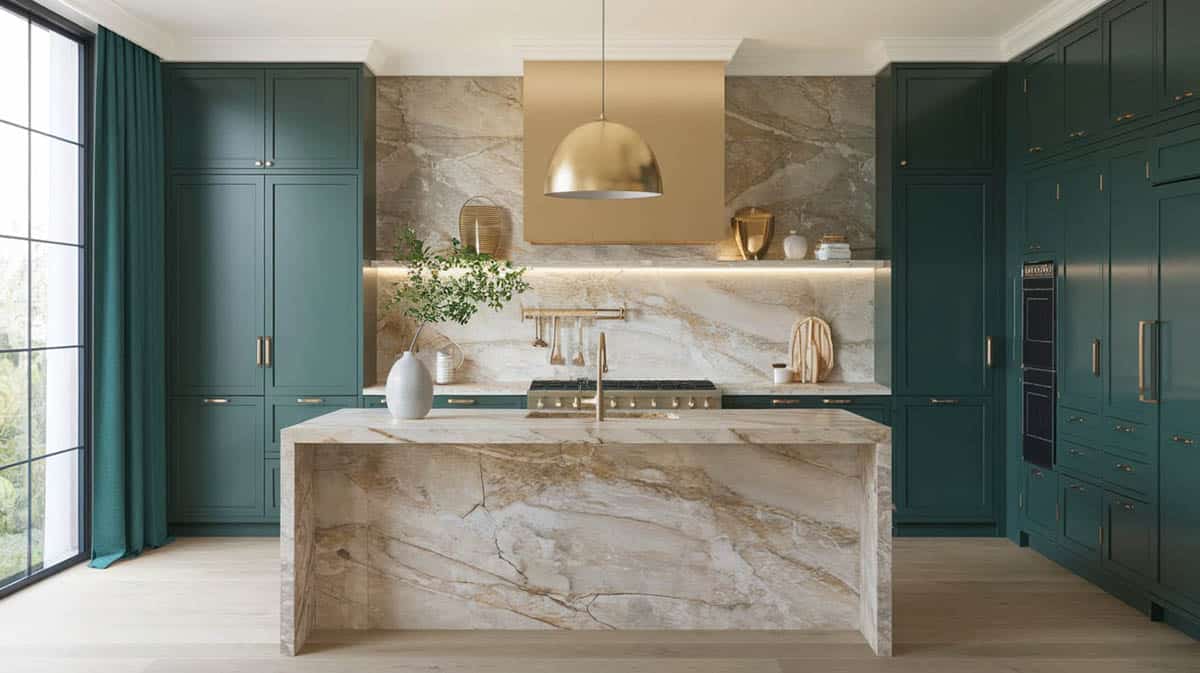
Forest green kitchen cabinets have emerged as a sought-after design choice, representing a dramatic shift from the safe neutrals of years past. This rich, organic hue strikes the perfect balance between bold impact and timeless charm. The color’s versatility enables it to transcend style boundaries. Modern spaces use forest green to create sleek, contemporary statements when paired with minimalist lines. Traditional kitchens embrace the same shades to evoke cozy cottage warmth. This adaptable nature makes forest green uniquely exceptional in any home. Let’s explore how to use forest green kitchen cabinets for your own design.
(Images generated using AI to showcase potential design ideas.)Selecting the Perfect Forest Green
Color psychology provides insight into our attraction to this tranquil shade. As our ancestral tie to nature still resides within, bringing an organic color like green indoors promotes harmony and wellbeing. Specifically, forest green carries the restorative energy of lush woods and gardens. The kitchen becomes a natural sanctuary when enveloped in this dynamic color.
Shades range from deep hunter greens with strong blue undertones to brighter emerald variations. Testing large samples throughout daylight hours is essential, as lighting dramatically impacts color appearance. Warm forest greens with yellow/brown undertones provide an inviting cozy atmosphere. Cool forest greens with blue/gray undertones offer a more polished look. Consider how the shade complements your existing design. Highly recommended forest green paint colors include:
- Benjamin Moore Hunter Green 2041-10
- Farrow & Ball Green Smoke No. 47
- Sherwin-Williams Mountain Road SW 7741
- PPG Forest Green 1134-7
Remember to test samples on your cabinet materials, as the surface impacts color appearance. Let forest green turn your kitchen into nature’s sanctuary.
Design Styles That Embrace Forest Green Cabinets
Let’s explore some winning design styles for forest green cabinets and how to make this colorful choice shine.
Modern Farmhouse Charm
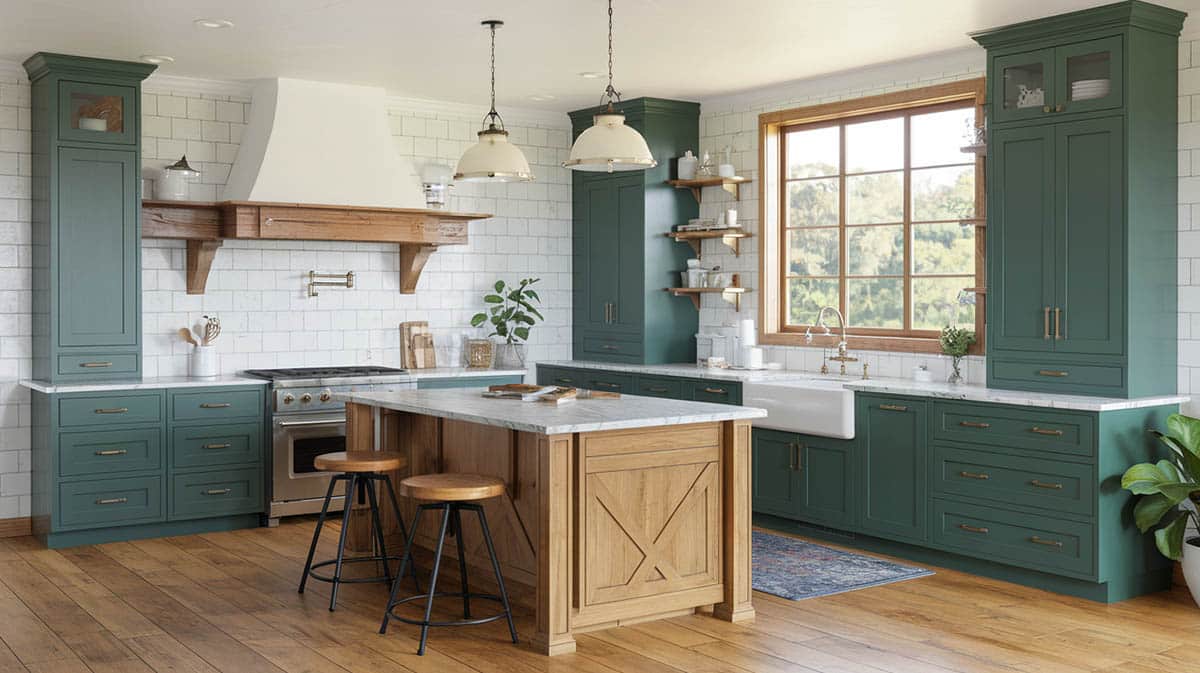
A modern farmhouse kitchen can look stunningly inviting with a green, white and black color palette. One can opt for simple Shaker-style doors with matte black hardware. Contrast vibrant green cabinets with breezy white walls, natural wood accents, and plenty of daylight. The mix of rich color and rustic textures creates a fresh contemporary-meets-country look.
Timeless Traditional Elegance

For a more refined traditional aesthetic, forest green cabinets lend historical character and grace. Opt for raised panel doors dressed up with detailed trim and brass hardware for a polished yet inviting statement. Pair forest green with classic white Carrara marble counters, beadboard backsplashes, and glass-front upper cabinets to display heirloom china. Crystal chandeliers cast an elegant glow over the space. The result channels old-world refinement through a forest green filter. In addition to regular traditional styles the farmhouse design works with this paint tone for its cabinetry.
Sleek, Modern and Dramatic
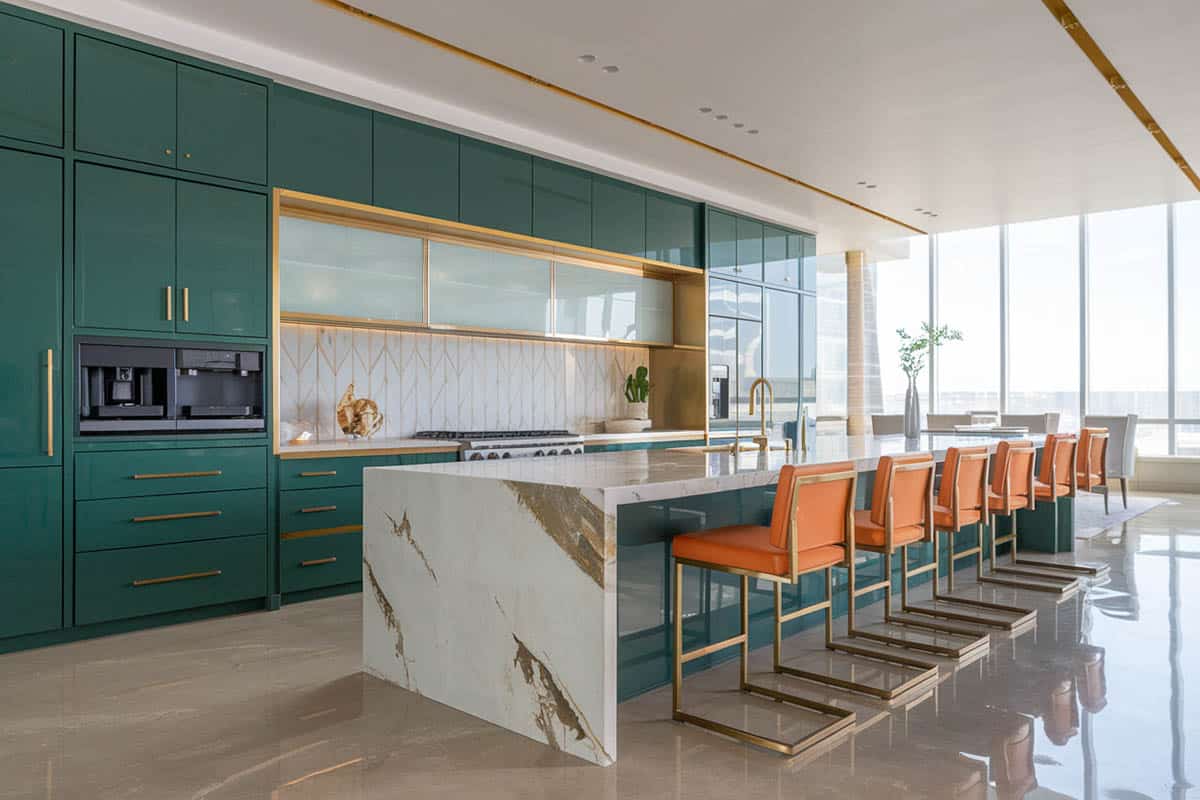
Contemporary spaces allow forest green cabinets to take center stage. Set against a backdrop of crisp white walls and minimalist fixtures, vibrant green makes a dramatic style statement. Slab cabinet fronts with recessed handles keep lines clean and uncluttered. Edge-grain waterfall counters and a seamless wall oven amp up the modern factor. The rich color pops against this pared-down backdrop of metallic accents and geometric forms for maximum visual impact.
Quintessential English Cottage
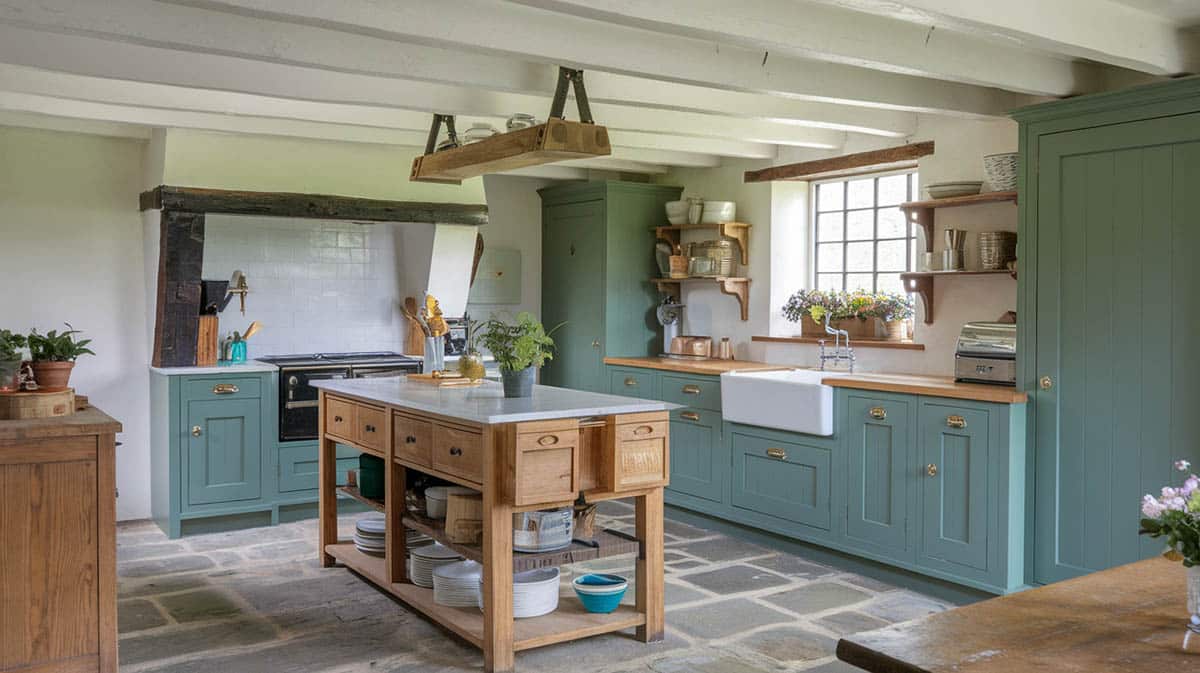
For a cozy English cottage vibe, forest green cabinets hit the style bullseye. Picture a natural stone floor, climbing ivy in the window sill and a farmhouse sink framed by an emerald green cabinet run. Visible hinges and antique copper hardware play up the old-world charm. Open shelves give heirloom tableware a place to shine while glass cabinet fronts provide breezy visibility. The look blends cottage coziness with verdant garden hues.
Transitional: The Best of Both Worlds
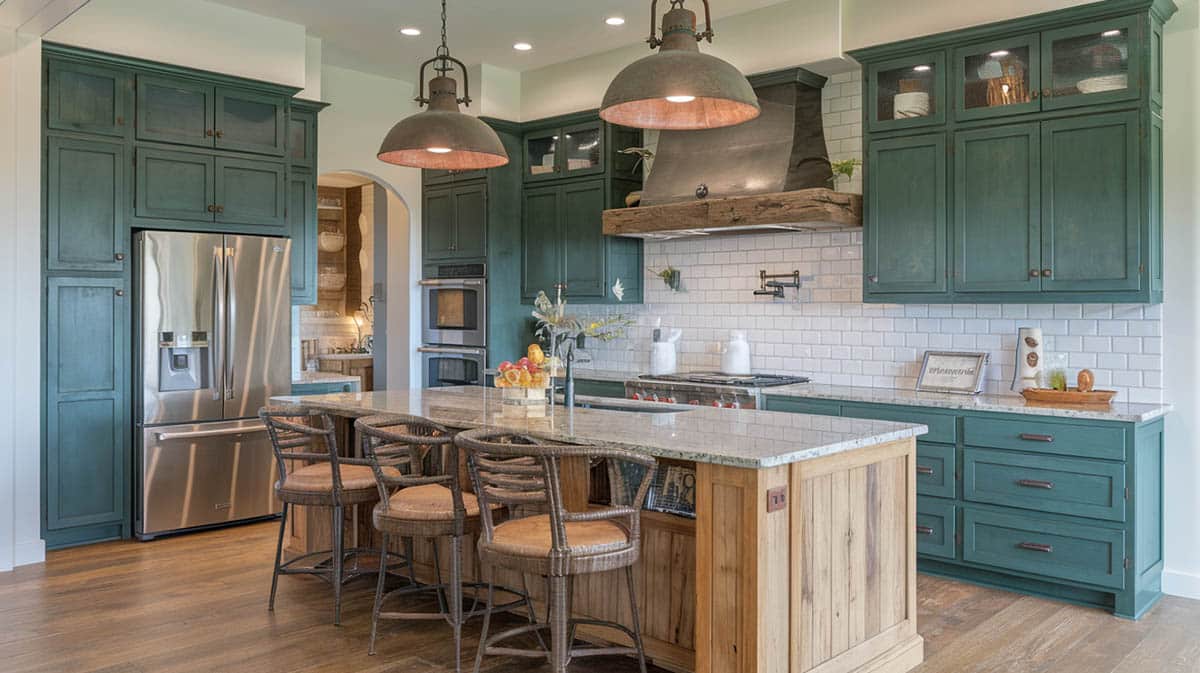
If you can’t choose between old and new styles and finishes, a transitional style may be what you want. Mix traditional raised panel cabinet doors with modern flat-front designs unified by brushed nickel hardware. Incorporate architectural details like crown molding and accent lighting alongside contemporary pendant fixtures. Blend natural materials like wood and stone with sleek surfaces and clean lines. Forest green cabinets anchor the look, styling in both directions effortlessly.
Mastering the Color Balance
Finding the perfect balance with bold forest green cabinets can seem tricky, but it’s all about smart distribution and complementary colors. By following some fundamental design strategies, you can create a stunning, intentional kitchen with just the right amount of drama.
Many designers swear by using forest green only on the lower cabinets. Visually, this grounds the space without making it feel too dark or overwhelming. It also creates fantastic contrast when paired with light upper cabinets. Going two-tone in this way can make your kitchen appear larger and infuse it with character. The rich-green bases become the perfect springboard to layer on other elements. Extending the same hue to your kitchen island helps tie everything together into one cohesive look, while still allowing light uppers to keep things airy.

Speaking of those light upper cabinets, they are key for balance. Classic white is a no-brainer contrast. But you can also try creamy uppers for a softening transitional effect. Light gray cabinets establish sophisticated harmony, while natural wood uppers enrich the space with warmth and texture.
The most important consideration is choosing the right undertone in your lighter upper cabinets to complement the exact forest green hue on below. This creates a seamless, intentional color scheme that dazzles without dominating the space.
Breaking Up the Color with Glass Cabinets
When working with a rich, dark green cabinetry color, it can start to feel a bit heavy after a while. Too much of that saturated shade covering every cabinet face can seem dark and closed-in. Luckily, there’s an easy design trick to break up all that green – incorporate some glass cabinet doors!
Strategically choosing certain forest green cabinets to have glass fronts instead provides the perfect contrast. The transparency allows your eye to penetrate inside, letting in light and breathing space. Plus, the contents on display add visual interest. Good placements to consider are corner cabinets, upper cabinets flanking your range hood, the cabinet over the kitchen sink, or on the end of any long cabinet run.
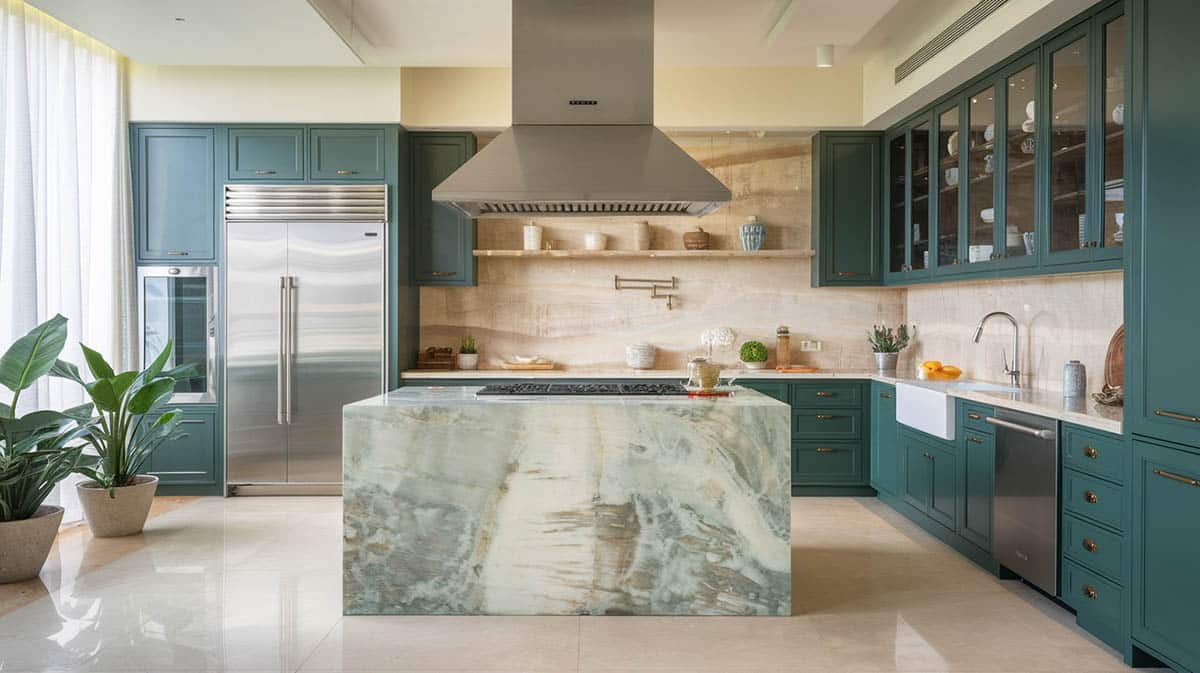
You have options for the type of glass too depending on the look you want. Clear glass fronts are great for openly displaying beautiful dishes, glassware or decorative items. The colors and shapes shimmer behind the glass, complementing the rich green backdrop. Seeded or reeded glass offer more texture and obscurity if you’ll store less eye-catching items there but still want a lighter look. And frosted glass fronts provide a modern vibe while allowing some privacy.
Creating Color Harmony With Countertops & Backsplash
Creating a color scheme that perfectly complements forest green kitchen cabinets can seem daunting, but it’s easier than you think! The key is choosing materials and hues that enhance, rather than compete with, the rich green. With the right pairings, you can transform your kitchen from simply beautiful to utterly striking.
When it comes to countertops, you have several elegant options. Classic white marble, like Carrara or Calacatta, creates a gorgeous contrast and its subtle gray veining adds lovely depth. The combo feels luxurious yet timeless, suiting modern and traditional spaces alike.
Alternatively, warm wood butcher block makes an organic, earthy pairing. Oak or walnut not only complements the green beautifully, but brings a cozy, welcoming vibe – perfect for farmhouse or craftsman styles. For a bold, dramatic contemporary look, opt for sleek black granite or soapstone. Just be sure to choose a honed over polished finish for a properly modern feel.
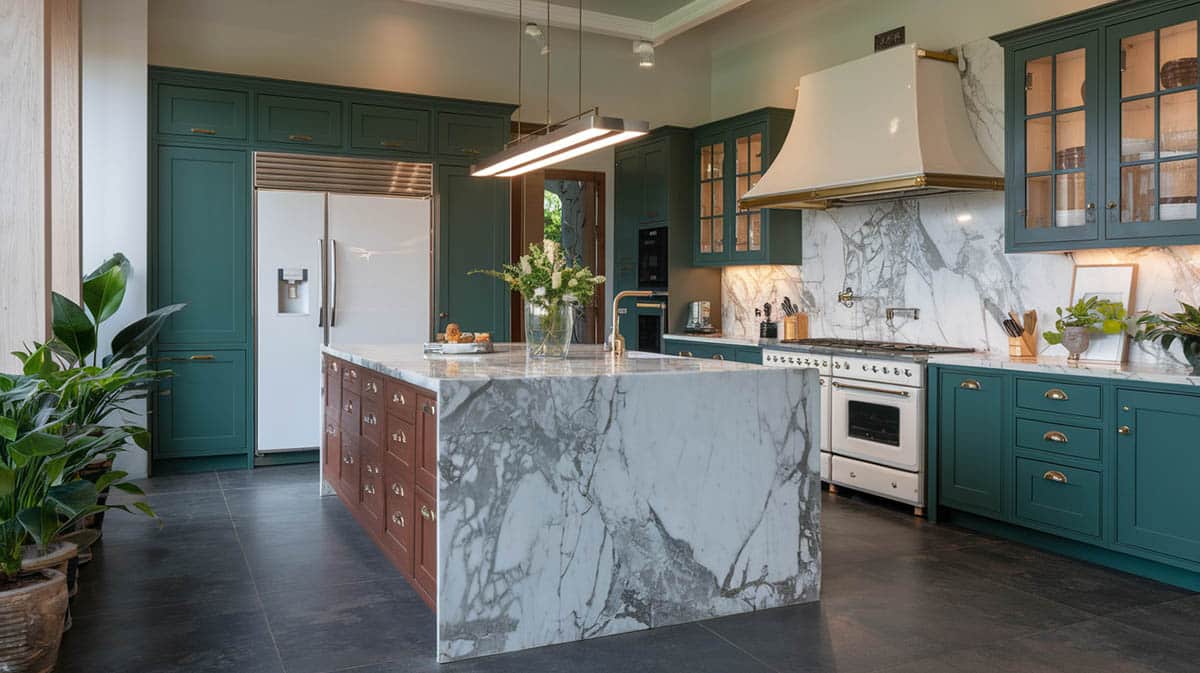
When choosing countertops and backsplash to match the cabinetry, go for light, bright materials to contrast its rich hue. A light stone or quartz countertop in a neutral tone works well. Mix up the textures with a polished quartz counter and then add an earthy, subtly veined mosaic tile backsplash. The variances in tone and texture add visual interest.
Another option is to keep it simple with a bright white quartz countertop and classic white subway tile backsplash. The crisp, clean white helps lighten up the deep green cabinets. Use subway tiles in varying sizes or patterns to give that traditional material a more modern, textural look. Accent the white with natural-edged stone shelves or trim for a hint of nature’s beauty.
Don’t overlook the power of your wall color either! Warm white, soft greige, cozy cream or light gray are all smart backdrops that highlight without competing. Avoid anything too flashy or saturated, as the rich green cabinets should take center stage.
Hardware That Makes a Statement
When it comes to cabinetry, the hardware you choose can make as much of a statement as jewelry. It’s amazing how something as small as a knob or handle can influence the overall look and feel so much.
Take unlacquered brass for example. As it develops a glorious patina over time, the warmth of the brass against the forest green cabinets creates an instantly classic look – both traditional yet fresh. Or if you prefer a more contemporary vibe, matte black hardware provides clean lines and subtle drama without overwhelming the space. The high contrast looks especially sharp in modern kitchens.
Polished nickel is a great middle ground if you enjoy both traditional and contemporary design. It has a bit more personality than basic stainless steel with its subtle warm undertones. Plus, it is versatile enough to work in just about any style kitchen.
Now here’s a little pro tip when selecting your hardware: feel free to thoughtfully mix up those finishes for extra depth! Maybe try some brass cabinet pulls paired with a polished nickel sink faucet. Or combine striking matte black handles on the lower cabinets with warm brass pendants hanging above the kitchen island. This type of deliberate mixing creates a curated look that feels personal rather than matchy-matchy.
Incorporating Neutral Elements
When designing a kitchen, it’s important to think beyond just the cabinet colors. Integrating neutral elements throughout the space creates balance and allows the main colors to sing.
The flooring sets the foundation with warm, light hardwoods underfoot. Durable neutral tiles ground the high-traffic areas in timeless style. Delicate veins of natural stone bring organic texture in soothing earth tones. For completely carefree maintenance, light luxury vinyl adds a refined look with serious practicality.
Crisp white shiplap provides charming texture and contrast on the walls while allowing cabinet colors to pop. Soft, subtle wallpaper patterns in creamy neutrals add quiet interest without competing. And there’s just something uplifting about keeping the ceilings bright white – it maintains an airy feel overhead.
Understanding Undertones
Mismatched undertones can create a disjointed, visually chaotic feeling even if the colors initially seem complementary. A big reason for clashing undertones is the mixing of warm and cool shades of green, using countertops with competing tones, selecting wood finishes that don’t match, and combining metals that don’t work together.
To avoid this, test out physical samples of woods, metals, stones, paint chips, and fabrics in the actual room before fully committing. Look at them in both natural and artificial light to see subtle differences in undertones. Compare potential choices side-by-side to see how they interact. Consider the overall color scheme you want – does it skew warm or cool?
The key is consistency in undertones. If going for a warm look, choose woods, metals, counters, and paint colors with golden, peachy undertones. For a cool style, opt for silvery, bluish undertones. Use one undertone family throughout like a musical score to harmonize the look
How to Manage Bold Elements
When working with bold forest green cabinets, it’s tempting to go overboard and create a chaotic kitchen. We all want a showstopping space, but restraint is key for elegant design. I like to follow the “One Star Rule” – let those rich green cabinets shine in the spotlight by themselves.
Support them with quieter co-stars like a neutral stone or marble backsplash, simple hardware, and countertops that pick up the cabinet color without competing. Busy tiles or competing loud paint colors just distract. Keep the background simple to let people focus on the star of your kitchen – the cabinetry.
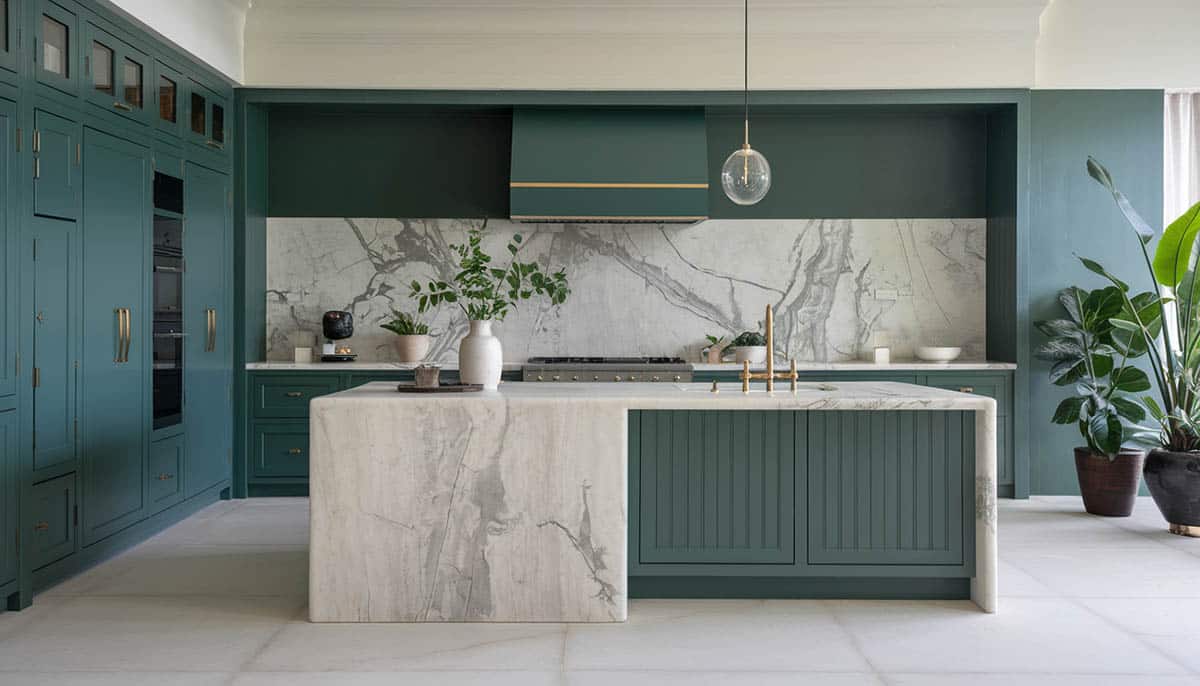
I’m not saying you can’t add any other statement pieces though! Just make sure to give them breathing room from the cabinets. A dramatic light fixture looks fab if it’s at the other end of the kitchen. Mix multiple patterns in small doses – don’t go overboard. And choose fixture metals and accent colors that relate nicely to the main cabinet green.
Most importantly, think about scale and proportion. A tiny mosaic tile backsplash might get lost next to tall cabinetry. The key is keeping the bold green cabinets as the obvious focal point while other features play a supporting role. It creates a polished, intentional look.
Designer Tips For The Perfect Earthy Green Kitchen Design
Creating the perfect palette is an art – and just like an artist, take inspiration from the 60-30-10 rule. Choose a rich, dominant forest green for 60% of the space to create an enveloping backdrop. Then introduce a secondary neutral tone like beige or grey for 30% of the accents.
Use it in key furniture pieces to allow the green to shine while adding warmth. Finally, add a pop of brightness with a copper, brass or gold for 10% of the details. This golden ratio infuses your kitchen with harmony.
When working with rich, earthy forest green cabinets, it’s important to create the right balance in your kitchen design to make them shine. A common mistake is allowing the cabinets to appear too dark or dull.
The key is to add plenty of light. Relying solely on overhead ceiling fixtures often casts shadows, making forest green look almost black. Instead, think about layering your lighting. Keep those ambient ceiling lights for general illumination, but also consider adding task lighting under the upper cabinets to brighten the space. Don’t forget under-cabinet lighting too – positioning lights to shine directly on the lower cabinets really makes the color pop.
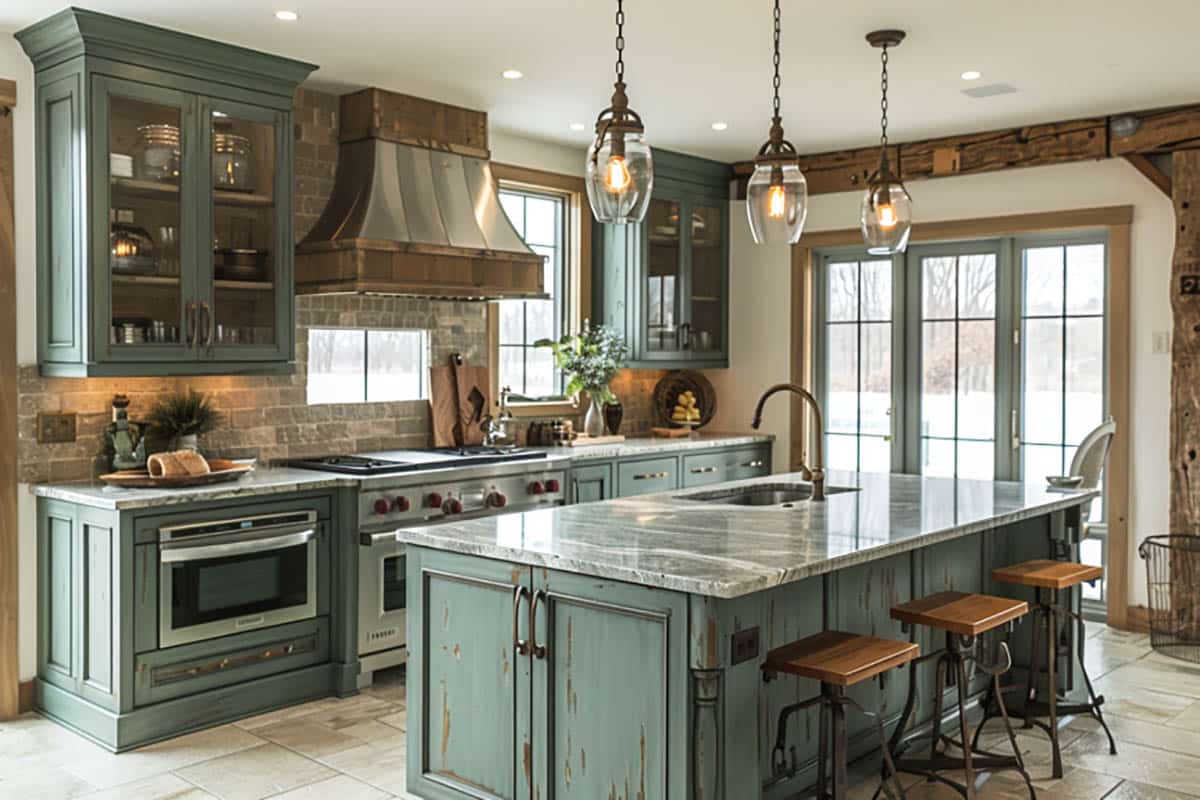
What about the rest of the kitchen elements? Choose bright, reflective surfaces like a white marble countertop and backsplash tile. The contrast showcases the green cabinets beautifully. You’ll also want to strategically incorporate plenty of white space. For example, a white or off-white island, light-colored floors and white trim work perfectly to lift the look. The goal is to let the cupboards take center stage so their rich color can be fully appreciated.
When it comes to lighting fixtures, placement matters. Position pendants directly over areas like the kitchen island and sink to cast helpful task lighting. Recessed ceiling lights should hit at least the first couple feet of wall space to avoid shadows. For bulbs, stick with bright, cool daylight in the 5000-6500K color range to keep things fresh. The right lighting makes all the difference to avoid cabinetry from appearing too dark.
In sun-filled kitchens, forest green appears more vibrant, allowing you to use darker shades and more of this bold color. Natural light adds dimension through window reflections. In darker kitchens, opt for slightly lighter green tones. Strategically place mirrors to bounce more light around. Glass-fronted upper cabinets also reflect light well.
Before finalizing your forest green shade, observe how natural light moves through the kitchen all day long. The changing sunlight patterns significantly alter how the green looks at different times.
Designing with forest green cabinets means considering your home’s overall aesthetic and choosing compatible decorative details. But creative mixes also work beautifully. Just use forest green as a base layer and build upward from there for a uniquely personalized kitchen that delivers style and soul.

